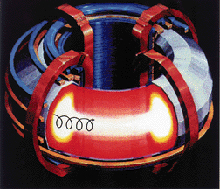![]()

SPIRALING CHARGED PARTICLES move in paths that nearly follow
the magnetic field lines. In an important application of magnetic fusion
confinement, the field lines thread the inside of a donut shaped volume,
never hitting the walls of the confining device. Consequently, the plasma
particles spiral about these field lines, and hot plasma at temperatures
in excess of 100,000,000 degrees centigrade (the temperature of the sun)
can be confined inside a metal chamber whose surface is nearer room temperature.
Perhaps the simplest of all "plasma confinement" devices is a bundle of straight field lines (produced by external, current-carrying coils) capped at two endpoints by plates that are electrically biased. Such a device confines a cloud of just one plasma species-positively charged protons, say, if the plates are biased positively to repel these particles as they try to escape along field lines. These simple and elegant devices will provide researchers with some of their best opportunities to do basic studies of waves and turbulence in plasmas in the coming years. Because the confined particles are completely isolated from contact with the outside world, these devices, unlike almost any other, can also serve as a "bottle" for containing antimatter-such as electrons' antimatter counterparts, called positrons-which would be annihilated in any encounter with ordinary matter. Plasma researchers have already confined more than 100 million positrons for up to an hour in such a trap in order to study how they might behave in the exotic corners of the universe where such clouds are thought to form naturally.
Externally imposed fields greatly expand a plasma's repertoire of behaviors, leading to waves with different phase velocities along and across the magnetic field lines, for example, and introducing new types of collisionless damping.
TURBULENT PLASMA STRUCTURES align along magnetic fields and
cause spiraling charged particles to wiggle and squirm across the field
lines. This fine-scale chaotic motion causes heat to be transported from
within the hot plasma core to the much cooler edge. The control of this
energy transport mechanism often determines how efficiently fusion (the
energy production mechanism that heats stars) can be used for power production
on Earth. [Courtesy, W. Lee and S. Parker, Princeton Plasma Physics Laboratory]
The truly sublime complexity of the science doesn't become apparent,
however, until you realize that magnetic fields in plasmas don't generally
remain fixed, but squirm about in turbulent plasmas, an equal partner with
the fluctuating electric fields and the particles in determining the overall
dynamics. Magnetic fields, in fact, seem to be the universe's ultimate weed,
sprouting spontaneously in the sun and stars, in planetary cores and in
interstellar, interplanetary and intergalactic space. The study of how electrical
currents in the plasma both generate these fields and are affected by them
goes under the name of dynamo theory, and it counts as one of the more vigorously
developing areas in plasma science today.
![]()
The sun and its environment give a sample of the cauldron of activity such processes introduce. Deep beneath the solar surface, dynamo effects generate tubes of magnetic flux that can bob up and form great arches that become visible as striations of plasma in the solar atmosphere. The "footpoints" where the flux tubes emerge from the surface often coincide with the relatively cool areas called sunspots. By poorly understood processes, generally referred to with the catch-all phrase "plasma instabilities," these arches, often carrying tremendous blobs of plasma with them, can suddenly erupt, hurling the plasma and the fields threading it out into space. Or magnetic interactions can violently heat a smaller volume of plasma, which then spits out fast particles and energetic radiation.
TURBULENT, WEED-LIKE magnetic structures emerging from the
solar surface, as observed by the Soft X-ray Telescope experiment on the
Yohkoh solar research spacecraft of the Japanese Institute of Space and
Astronautical Science (ISAS). [The x-ray telescope was prepared by the Lockheed
Palo Alto Research Laboratory, the National Astronomical Observatory of
Japan, and the University of Tokyo with the support of NASA and ISAS]
If any of this solar shrapnel strikes the magnetic field that shrouds the Earth-a plasma-filled structure called the magnetosphere-the result can be geomagnetic storms that can destroy delicate satellite equipment and knock out power grids on the ground. On a more cheerful note, when the charged particles generated from these processes speed along field lines where they plunge into the Earth at the magnetic poles, the particles crash into nitrogen and oxygen atoms in the upper atmosphere and produce the beautiful aurorae or Northern and Southern Lights. All of these phenomena take place in response to the continual outward gusts of particles from the sun, called the solar wind. In general, predicting the vagaries and vicissitudes of this "space weather" is a major motivation for studying plasmas in the solar system.